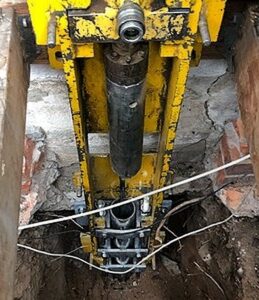It’s no secret – foundation repair isn’t the cheapest process in the world. You want to find the perfect contractor that fulfills your foundation repair needs. That said, you need to know you’re getting your money’s worth and are comfortable with a foundation repair contractor.
You don’t want to get “scammed” out of your hard-earned money.
There isn’t too much in terms of scams regarding foundation repair. Rather, there are less effective methods and sales tactics you need to keep in mind. They’re “scammy” types of tactics.
If your gut tells you not to go with a contractor for your foundation repair, listen to it.
Dalinghaus Construction has over 100 years of combined experience in Southern California, Arizona, and Nevada. We’ve seen and heard of many manipulative tactics companies use to get you to sign a foundation repair contract. There’s no reason for you to agree to a plan you’re uncomfortable with. We want to inform you what you need to look out for when it comes to your foundation repair.
Secure and Protect
Sometimes companies will try to sell you things you don’t need. They’ll oversell and use the phrase “secure and protect” to try and address issues that aren’t there.
For example, if your home has settled half an inch, some companies will try to convince you to pier your entire home.
The industry standard is half an inch over a ten-foot or an inch over a 20-foot span before it’s recommended the area of the home affected should have some type of piering. These are inches of threshold that mean you’re facing some sort of foundation settlement or heaving.
If any of the measurements we make are under these standards, we suggest monitoring the area. You might not see signs and symptoms of a failing foundation. You can still have piering done if you’re paranoid about further settlement if you so choose.

Most honest foundation repair contractors will tell you that you only need piers in the affected area. However, others will say you need to pier your whole home. It used to be a recommendation, but more companies are telling you it’s necessary.
Piering your whole home is not necessary unless your whole home is affected – which is extremely rare. Like, extremely rare.
There are some instances piering your entire home makes sense, but you need to see the evidence first.
But you will see signs and symptoms of foundation issues with your home in specific areas of your home.
Here are the signs and symptoms to look for
- Drywall cracks
- Stucco cracks
- Concrete slab cracks
- Ceiling cracks
- Tile cracks
- Chimney cracks
- Leaning chimney
- Sloping floors
- Doors and windows are hard to open and close
- Water leaks
When looking for these signs and symptoms, it won’t be one of the problems you’ll see to indicate foundation issues. More than one of these symptoms is an indicator of foundation failure.
Make sure you see proof and who’s making the proper recommendations
Don’t agree to anything if tests haven’t been done. You need a basis for those recommendations.
No one will reasonably tell you to put piers all around your home unless they have a recommendation from a soil engineer or structural engineer.
Make sure you see the floor elevation readings and that there are clear signs of obvious damage.
Foundation repair contractors will attack the areas affected with clear signs of damage. It’s the ones making recommendations without proof that you need to listen to your gut.
Some companies will make repair plans without floor elevations. Make sure you can see the floor elevations on those plans.
Foundation repair companies fix the areas affected at the time
Why would you need to put a push pier or helical pier underpinning for your home when one corner is affected? Why put piers under your entire home when parts of it aren’t being affected?
When you pier your entire home, you’ll pay a hefty price. Addressing the areas affected is more affordable and practical. The average cost for foundation repair from Dalinghaus Construction is around $26,000. And that’s for the area(s) affected.
Other phrases to be cautious of
You need to pier the whole house
This is rarely true and something you want to be sure you have proof of. Needing piers for your entire home is so rare as it is. Look at the proof. Don’t take anyone’s word for it.
This is gonna get worse
While this statement isn’t entirely wrong, you need to have a baseline. When you have a baseline, take another measurement a month or so later. Then you’ll know it’s worse.
Honest foundation repair contractors might also tell you foundation issues are likely to get worse. The point is to not have the phrase used against you to pressure, fearmonger, and sign a contract.
“This is dire.”
Please, slow down there, salesperson.
You don’t want your foundation issues to become worse over time, and rightfully so. However, don’t let anyone fearmonger you and pressure you to have this done sooner than later.
Foundation heaving or foundation settlement is a slow process unless there is something like seismic activity making the foundation issues much worse. If you see some cosmetic damage, there’s time to think about your foundation repair.
Don’t let anyone pressure you into a repair you’re not comfortable with.
That said, if you can see sunlight moving past the crack in your ceiling, you might want that repair done sooner than later.
Don’t give in to pressure

If someone is trying to wear you down to sign a contract, don’t give in. Some salespeople will try for hours with presentations and fear tactics. If you feel that someone is adding more and more pressure, that’s enough to make alarms go off.
Dalinghaus Construction will do a free 60-90 minute foundation evaluation of your home to look for any potential problems. We’ll let you know of any foundation issues. We’ll also let you know if we don’t find any issues. As simple as that.
Less effective foundation repair methods that might be suggested to you
Concrete underpinning
To make it clear, not all concrete underpinnings are “bad.” There are variations such as concrete piers, concrete pads, and caissons. Caissons are effective but twice as expensive as galvanized steel underpinnings.
You want to check out our article on concrete underpinnings vs galvanized steel piers for a better understanding of which foundation repair methods work.
Mudjacking
This method of repair is old and outdated. This pumps concrete under your home to fill in voids and possibly raise your home. The issue with this is concrete takes forever to cure and it’s heavy, meaning there’s extra weight added to the soil. That weight with gravity can cause more problems.
Compare this to polyurethane foam, which takes up to 15 minutes to cure and is significantly lighter. Polyurethane foam is 97% lighter than mud slurry. Plus, it doesn’t contract as it cures, unlike concrete.
Read more on polyurethane vs mudjacking.
Watering your soil
This will never fix the issue. It’s a temporary bandaid to a larger problem. Expansive soil will soak in water and expand, which can be a temporary fix to foundation issues. But when the soil gets dry, those foundation problems come back. They never truly went away.
Review the contracts you receive
When it comes to foundation repair, you want to be sure you have bids from multiple contractors. You’ll also receive multiple contracts.
Read them side by side and make sure they say similar things. Compare them apples to apples.
Always read the fine print.
Look at reviews
Always look at third-party reviews from Google reviews, Yelp, and Angi (formerly Agni’s List) to get an idea of how certain contractors work. Some are notorious for having a cheaper repair plan only to give you a change order later down the line.
Change orders aren’t fun for anyone. And people will let you know their thoughts on receiving one.
Listen to your gut
If you’re talking to someone inspecting your home and get a bad vibe to where you’re stomach is telling you not to move forward with a contractor, listen to it.
And don’t be afraid to say no. And don’t let anyone coerce you into saying yes.
You now know what to look out for. Make sure you get multiple foundation repair bids.

You learned what phrases to look out for, less effective foundation repair methods, to look at reviews, and to listen to your gut. The last thing you do before deciding on a contractor is to make sure you get multiple foundation repair bids.
This is important to do to get an overall feel of a company and to be able to compare repair plans. This way you can sus out who is honest and compare that to who is trying to get more out of you.
Learn more in-depth about why you should receive multiple foundation repair bids. That way you can take on the next challenge.
If you’re comfortable, consider having Dalinghaus Construction do a FREE 60-90 minute foundation evaluation.
For additional questions or to schedule an evaluation, call Dalinghaus Construction at (877)360-9277.






